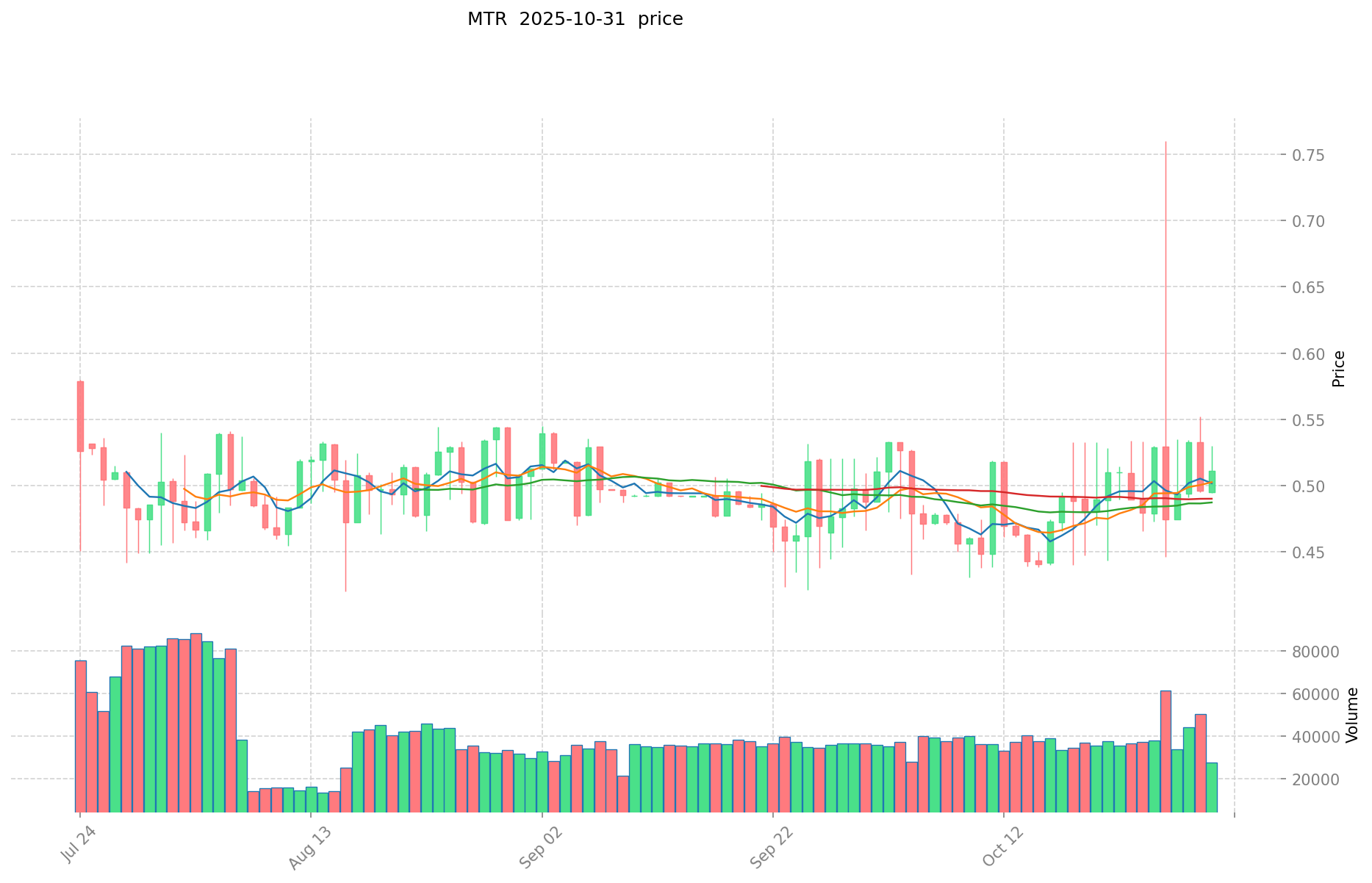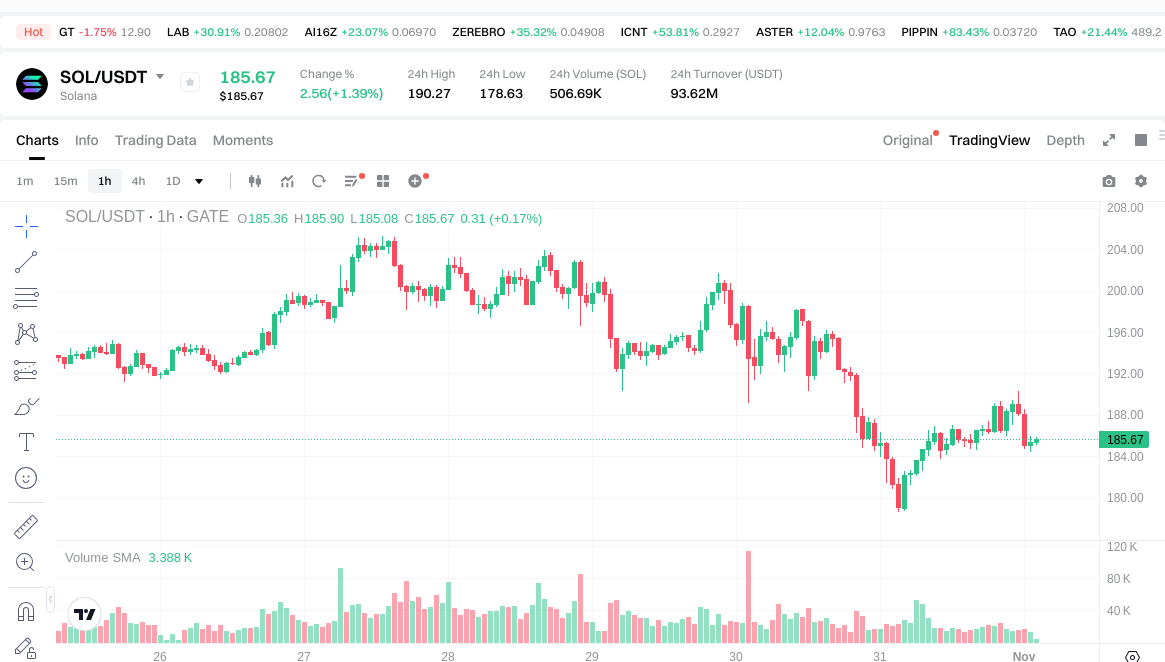MTR vs SOL: Which Transportation System Offers a Better Urban Experience?
Introduction: MTR vs SOL Investment Comparison
In the cryptocurrency market, MTR vs SOL comparison has always been an unavoidable topic for investors. The two not only have significant differences in market cap ranking, application scenarios, and price performance, but also represent different cryptocurrency asset positions.
MTR (MTR): Since its launch, it has gained market recognition for its low volatility and energy-efficient mining process.
SOL (SOL): Since its inception in 2017, it has been hailed as a high-performance blockchain protocol, and is one of the cryptocurrencies with the highest global trading volume and market capitalization.
This article will comprehensively analyze the investment value comparison between MTR and SOL, focusing on historical price trends, supply mechanisms, institutional adoption, technological ecosystems, and future predictions, and attempt to answer the question that investors care about most:
"Which is the better buy right now?"
I. Price History Comparison and Current Market Status
MeterStable (MTR) and Solana (SOL) Historical Price Trends
-
2021: SOL experienced significant growth due to increased adoption in DeFi and NFT sectors, with price rising from around $1 to an all-time high of $260.
-
2022: MTR maintained relatively stable price levels due to its design as a low-volatility token, while SOL faced challenges during the broader crypto market downturn.
-
Comparative analysis: During the 2021-2022 market cycle, SOL saw a dramatic rise from under $5 to over $250, followed by a correction to around $10, while MTR demonstrated lower volatility in line with its design.
Current Market Situation (2025-11-01)
- MTR current price: $0.5195
- SOL current price: $185.5
- 24-hour trading volume: MTR $10,576.93 vs SOL $93,614,040.46
- Market Sentiment Index (Fear & Greed Index): 29 (Fear)
Click to view real-time prices:
- View MTR current price Market Price
- View SOL current price Market Price


Core Investment Value Factors: MTR vs SOL
Supply Mechanism Comparison (Tokenomics)
- MTR: Limited information available on supply mechanism
- SOL: Inflationary model with staking rewards, with periodic token burns to control supply
- 📌 Historical Pattern: Supply mechanisms typically drive price cyclicality through scarcity principles and market equilibrium dynamics.
Institutional Adoption & Market Applications
- Institutional Holdings: Limited comparative data available
- Enterprise Adoption: Both assets appear to be in early adoption phases for payments and settlements
- Regulatory Stance: Regulatory frameworks still developing across jurisdictions for both tokens
Technical Development & Ecosystem Building
- MTR Technical Updates: Insufficient data available
- SOL Technical Development: Focus on scalability and transaction throughput improvements
- Ecosystem Comparison: SOL has established presence in DeFi and NFT applications
Macroeconomic Factors & Market Cycles
- Inflation Performance: Cryptocurrency assets generally considered as potential inflation hedges
- Monetary Policy Impact: Interest rates and USD strength typically affect overall crypto market sentiment
- Geopolitical Factors: Cross-border transaction demand may increase utility value of both assets III. 2025-2030 Price Prediction: MTR vs SOL
Short-term Prediction (2025)
- MTR: Conservative $0.26 - $0.52 | Optimistic $0.52 - $0.71
- SOL: Conservative $105.58 - $185.23 | Optimistic $185.23 - $214.87
Mid-term Prediction (2027)
- MTR may enter a growth phase, with prices expected in the range of $0.59 - $0.73
- SOL may enter a bullish market, with prices expected in the range of $135.88 - $360.71
- Key drivers: Institutional fund inflows, ETF, ecosystem development
Long-term Prediction (2030)
- MTR: Base scenario $0.90 - $0.95 | Optimistic scenario $0.95 - $1.04
- SOL: Base scenario $351.18 - $372.25 | Optimistic scenario $372.25 - $400.00
Disclaimer: The above predictions are based on historical data and market analysis. Cryptocurrency markets are highly volatile and subject to change. This information should not be considered as financial advice. Always conduct your own research before making investment decisions.
MTR:
| 年份 | 预测最高价 | 预测平均价格 | 预测最低价 | 涨跌幅 |
|---|---|---|---|---|
| 2025 | 0.708152 | 0.5207 | 0.265557 | 0 |
| 2026 | 0.7680325 | 0.614426 | 0.50997358 | 18 |
| 2027 | 0.7257907125 | 0.69122925 | 0.594457155 | 33 |
| 2028 | 1.04859477225 | 0.70850998125 | 0.4747016874375 | 36 |
| 2029 | 0.931265519355 | 0.87855237675 | 0.509560378515 | 69 |
| 2030 | 1.040645290260375 | 0.9049089480525 | 0.8687125901304 | 74 |
SOL:
| 年份 | 预测最高价 | 预测平均价格 | 预测最低价 | 涨跌幅 |
|---|---|---|---|---|
| 2025 | 214.8668 | 185.23 | 105.5811 | 0 |
| 2026 | 294.071148 | 200.0484 | 154.037268 | 7 |
| 2027 | 360.70727004 | 247.059774 | 135.8828757 | 33 |
| 2028 | 349.466050323 | 303.88352202 | 158.0194314504 | 63 |
| 2029 | 375.676004097225 | 326.6747861715 | 248.27283749034 | 76 |
| 2030 | 372.24591884242425 | 351.1753951343625 | 224.752252885992 | 89 |
IV. Investment Strategy Comparison: MTR vs SOL
Long-term vs Short-term Investment Strategies
- MTR: Suitable for investors focused on low volatility and stability
- SOL: Suitable for investors interested in ecosystem growth and DeFi/NFT potential
Risk Management and Asset Allocation
- Conservative investors: MTR: 70% vs SOL: 30%
- Aggressive investors: MTR: 30% vs SOL: 70%
- Hedging tools: Stablecoin allocation, options, cross-currency portfolios
V. Potential Risk Comparison
Market Risk
- MTR: Limited liquidity and trading volume
- SOL: Higher volatility and susceptibility to market sentiment
Technical Risk
- MTR: Scalability, network stability
- SOL: Network outages, security vulnerabilities
Regulatory Risk
- Global regulatory policies may have differing impacts on both assets
VI. Conclusion: Which Is the Better Buy?
📌 Investment Value Summary:
- MTR advantages: Low volatility, potential stability in market downturns
- SOL advantages: Established ecosystem, high performance, DeFi and NFT applications
✅ Investment Advice:
- New investors: Consider a balanced approach with higher allocation to MTR for stability
- Experienced investors: Explore SOL's ecosystem potential while maintaining MTR for diversification
- Institutional investors: Evaluate both assets based on specific portfolio needs and risk tolerance
⚠️ Risk Warning: The cryptocurrency market is highly volatile. This article does not constitute investment advice. None
VII. FAQ
Q1: What are the main differences between MTR and SOL? A: MTR is designed for low volatility and stability, while SOL focuses on high performance and ecosystem growth. MTR has maintained relatively stable price levels, whereas SOL has experienced significant price fluctuations. SOL has a more established presence in DeFi and NFT applications.
Q2: Which cryptocurrency is better for long-term investment? A: The better long-term investment depends on your risk tolerance and investment goals. MTR may be suitable for conservative investors seeking stability, while SOL might appeal to those interested in ecosystem growth and higher potential returns. It's advisable to diversify and conduct thorough research before investing.
Q3: How do the supply mechanisms of MTR and SOL differ? A: Limited information is available on MTR's supply mechanism. SOL has an inflationary model with staking rewards and periodic token burns to control supply. These differences in tokenomics can impact long-term price dynamics.
Q4: What are the main risks associated with investing in MTR and SOL? A: MTR risks include limited liquidity and trading volume, while SOL faces higher volatility and susceptibility to market sentiment. Both cryptocurrencies are subject to technical risks such as scalability and network stability issues, as well as regulatory risks that may vary by jurisdiction.
Q5: How do institutional adoption and market applications compare between MTR and SOL? A: Both assets appear to be in early adoption phases for payments and settlements. SOL has a more established presence in DeFi and NFT applications. However, limited comparative data is available on institutional holdings for both cryptocurrencies.
Q6: What are the price predictions for MTR and SOL in 2030? A: According to the predictions, MTR's price in 2030 is expected to range from $0.90 to $1.04, while SOL's price is predicted to be between $351.18 and $400.00. However, these predictions are subject to market volatility and should not be considered as financial advice.
Share
Content